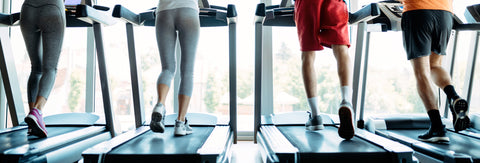While committing to better health is one of the most common New Year’s resolutions, starting an exercise regimen in the middle of a Canadian winter is hardly appetizing. Thankfully, treadmills allow you to run indoors, so for beginners, treadmills are a fantastic way to get either started, or back on track, regardless of your current fitness level.
If you’re new to working out, your first visit to a gym can be intimidating. The free-weight area is full of clanking plates, the resistance machines have strange names like “pec deck,” and the studio classes often proceed at a blistering pace. Luckily, the treadmill is the perfect tool for anyone who wants to embark on their first fitness regimen. Here are our top treadmill tips for beginners, plus a few treadmill workouts to help you conquer your fitness resolutions for 2019.
Walk before you can run
No matter how fast you’re used to running outdoors, start slow on the treadmill and don’t increase your speed until you’re completely comfortable starting, stopping, and staying on the machine. Trying to hit the treadmill running is a great way to injure yourself.

If you’re not used to running outdoors, and are just learning how to use the treadmill, be careful when you stop your workout. While you should be aware of the “stop now” button for emergencies, it’s best to cool down at a slower speed before coming to a complete stop. You should also take care not to step off of the treadmill until the belt has come to a total halt. And if you feel dizzy, don’t panic. Adjusting to the sensation of running on the spot can make you a little wobbly. This is absolutely normal and will go away quickly once you get used to the machine.
Ramp it up

Speed isn’t everything when it comes to running in place. While it’s great to push the pace, another way to increase your workout is by playing with incline settings. The added resistance will make for a more challenging workout, and the steeper angles will work your hamstrings and glutes (the large muscle groups at the back of your thighs) more than running on a level surface.
Side shuffle
If you’re looking for a more advanced way to work out on a treadmill, the side shuffle is for you. While it can be a little awkward at first, it’s a great way to build muscle in your legs while strengthening your core. To do this, set the treadmill to a slow walking pace. Turn yourself 90º while grasping the side rail that’s in front of you. Then, shuffle your feet laterally for about 60 seconds while keeping your knees bent, moving your feet side by side rather than crossing them over each other. After a minute, switch back to facing frontwards, steady yourself, and turn to repeat on the other side. If you can pull it off, it’s a terrific way to work your obliques (the muscle group that runs alongside your abs) and your inner and outer thighs on the treadmill.
Walk it back
Walking backwards on a treadmill isn’t just a way to show off; it’s a great way to work on your balance and activate your quads (the muscles at the front of your thighs). As with the side shuffle, it’s important to start slowly. While going hands-free will be better for your workout, make sure to start with a strong grip until you know you’ve got the hang of things. Once going backwards feels like second nature, try lunging backwards into a slightly deeper squat. You’ll probably feel it in your legs the next day, but it will be the good kind of soreness—the kind you can only get from a fantastic workout.
Pressed for time? Try HIIT on the treadmill

HIIT stands for “high intensity interval training,” and while it can sound a little bit intimidating at first, it’s probably the most efficient way to work out, especially if you’re strapped for time. When it comes to the treadmill, HIIT workouts are a simple concept: do short bursts of high-intensity running followed by slow periods of walking or light jogging. Repeat this cycle, sprinting for 15 to 30 seconds followed by a minute or two of walking. Do this a few times, and you’ll be burning calories more efficiently than ever. Studies have shown that doing a few minutes of HIIT makes for an excellent way to burn fat. If you’re in a race against the clock, Tabata workouts are a 4-minute version of HIIT that can drastically increase your metabolic rate. For the Tabata protocol, simply alternate 20 seconds of high-intensity work with 10 seconds of rest for eight “rounds,” adding up to a total of four minutes. Be prepared, however, to feel it the next day. You’re going to be sore, so offset aches and restore your muscles by using a protein supplement which contains all your essential nutrients after your workout.
Sometimes, slow is better than stopped
It sounds obvious, but one of the best benefits of a treadmill is the ability to set your own pace. Being tired or sore can affect your performance and hinder your ability to target certain muscle groups, but on your sore days, the treadmill is just as good for slow workouts as it is record-setting paces. If your joints are sore, walking on a steep incline will still have you sweating without punishing your knees. And if you’re stressed, studies have shown that walking is a great stress reliever. It’s also a great way to catch up on that podcast you’ve been putting off. Need another way to help your body recover? Aside from rest, supplementing with magnesium can help relieve muscle soreness.
--
REFERENCES:
Carmack CL, Boudreaux E, Amaral-Melendez M, Brantley PJ, de Moor C. Aerobic
fitness and leisure physical activity as moderators of the stress-illness relation. Ann Behav Med. 1999 Summer;21(3):251-7. PubMed PMID: 10626033.
Weston KS, Wisløff U, Coombes JS High-intensity interval training in patients with lifestyle-induced cardiometabolic disease: a systematic review and meta-analysis Br J Sports Med 2014;48:1227-1234.
Rognmo Ø, Moholdt T, Bakken H, Hole T, Mølstad P, Myhr NE, Grimsmo J, Wisløff U. Cardiovascular risk of high- versus moderate-intensity aerobic exercise in
coronary heart disease patients. Circulation. 2012 Sep 18;126(12):1436-40. Doi: 10.1161/CIRCULATIONAHA.112.123117. Epub 2012 Aug 9. PubMed PMID: 22879367.
Stephen H. Boutcher, “High-Intensity Intermittent Exercise and Fat Loss,” Journal of Obesity, vol. 2011, Article ID 868305, 10 pages, 2011. https://doi.org/10.1155/2011/868305.
Taghiyar M,Darvishi L, Askari G, Feizi A, Hariri M, Mashhadi NS, Ghiasvand R. The Effect of Vitamin C and E Supplementation on Muscle Damage and Oxidative Stress in Female Athletes: A Clinical Trial. Int J Prev Med. 2013 Apr; 4(Suppl 1): S16–S23.




